It’s no secret in the industry that air-cooled, retro-styled bikes are hot right now, and we are not referring to cruisers. Standards, café racers, and scramblers seem to have a cross-generational appeal. Older riders who remember similar styles from their younger days, and even younger riders who crave “authenticity” all become part of the target customer group. Yamaha has its Bolt platform to work with when appealing to this group.
The new SCR950 is essentially a Bolt with a revised subframe, different suspension settings (the shocks are borrowed from the Bolt C-Spec, but feature different valving and spring rate), long, flat seat, high bars, slightly up-swept exhaust canister and different foot peg position. Let’s not forget the gas tank that has no visible seams (you have to look for them).
The engine is the same 942cc, 60° v-twin, with four valves per cylinder, and 9:1 compression ratio. Together with roller rocker arms, forged pistons and a slightly oversquare bore/stroke ratio (85 mm x 83 mm), this helped the original Bolt stomp all over Harley’s 883 on a dyno chart, while providing a relatively broad, torquey power delivery. The engine delivers the same sort of vibes (and frequently blurred rear-view mirrors), and sounds associated with narrow angle v-twins.
Despite its Bolt underpinnings, the new SCR950 is considered a “sport heritage model” … a group of machines that includes some Yamaha liquid-cooled bikes, such as the XSR900 and VMAX. As Yamaha describes it, the “SCR950 combines classic Yamaha styling, tracing its roots back to the iconic DT250, with modern components in a motorcycle that blurs the line between ‘cruiser’ and ‘sportbike’.”
We don’t care much for labels, but there is a clear nod by the SCR950 to the popular “scrambler” category. Along with those high bars, flat seat and slightly up-swept exhaust, you get other styling elements like the number-plate side covers. There is substance here, as well, with steel fenders and spoked wheels carrying Bridgestone Trail Wing tires (including a 19″ front). Yes, these are tubed tires.
Working against the scrambler idea is the same suspension travel found on the other Bolt models, including 4.7 inches in front and 2.8 inches out back. Together with a claimed curb weight of 547 pounds (including a full, 3.4 gallon fuel tank), this bike certainly isn’t a dual sport, nor does it pretend to be. Nevertheless, Yamaha says you can do some light off-roading — something we tested at this press launch.
We rode the new SCR950 in and around Julian, California. Highways, twisty roads, broken asphalt, single-lane switchbacks and off-road trails were all included in our introductory ride. We came away impressed on a number of levels. We generally think the SCR950 meets Yamaha’s goals for the bike, i.e., that it is a return to the concept of a do-it-all motorcycle, simple and fun, and capable of commuting, touring and exploring. As we said when the bike was originally unveiled, we think the SCR950 is damn good looking, as well.
Sitting on the SCR950 for the first time in the hotel parking lot, we find the rider triangle very comfortable, with an easy reach to the high bars, plenty of room to move fore and aft on the flat seat, and a decent amount of leg room to the well-placed foot pegs. The familiar compromise with this engine, and other similar engines, is a fairly wide distance between the pegs, together with the right airbox cover pushing your knee outward.
Pulling away from a stop, we are reminded why we like this engine in the Bolt models. Together with good clutch feel and engagement, it is very easy to launch and pulls well over a relatively broad rpm spread. The solid mounted engine sends its share of vibes to the rider (and blurs the mirrors, except at relatively low rpm levels), but never proved bothersome during our 130 miles, or so, of riding.
The five-speed transmission offers a good spread of gearing, with fifth gear keeping revs in a comfortable range at highway speeds. Gear changes are smooth, and sure, when compared to most engines of similar design. We caught a false neutral, or two, during the day, but only when we got lazy with our left foot.
The suspension action is very good on the highway. Just as we experienced on the C-Spec, Yamaha has tuned the largely non-adjustable suspension (the only adjustment is spring preload on the rear shocks) very well. Small chop is absorbed without drama, but the suspension is firm enough, and seems to remain high in its travel, so that spirited riding on the street feels controlled. Bottoming is not an issue on the street — off-road it is (more about that later).
The seat is very firm, but offers good support and the ability to slide back-and-forth, which helps a bit on longer rides. Unlike most street bikes, we found sitting a few inches behind the gas tank about right, leaving space to move forward and shift weight to the front end when needed, such as when negotiating a series of tight corners. Off-road, the ergonomics work pretty well with the exception of the width of the bike at the foot pegs. Standing on the pegs feels natural, and comfortable with the bars high enough to negotiate corners from this position.
We did take the SCR950 off-road with some predictable, and unpredictable, results. Predictably, both ends of the suspension will frequently bottom if you are trying to ride quickly through even moderate chop (such as rain ruts just a few inches wide). We couldn’t have predicted that the relatively stiff chassis and low center of gravity, together with the smooth low-end power and competent Bridgestones, provides a surprising amount of traction and control. Doing power slides for the photographer was unexpectedly easy given the weight and girth of a bike that began life in the cruiser category (referring to the original Bolt).
The brakes have decent power and feel on the street, and were not overly touchy in low-traction conditions off-road. A reasonable amount of engine braking helps in both environments.
Our first impression of the SCR950 is one of a supremely stable, easy-to-ride bike that turns well and feels relatively nimble (the tall, narrow tires help — a 140/80 rear and 100/90 front). The bike is fun and will work well for beginners and experienced riders alike. If you are familiar with, and enjoy, the vibrations and sounds coming from a narrow angle v-twin, we can see plenty of reasons why you would park an SCR950 in your garage. Priced at an U.S. MSRP of $8,699, the SCR950 should be available next week in U.S. dealers. Color options are Charcoal Silver and Rapid Red (both pictured). Genuine Yamaha accessories will also be available soon, such as windshields, saddlebags, fork brace, skid plate, etc. Visit Yamaha’s web site for additional details and specifications.
See more of MD’s great photography:
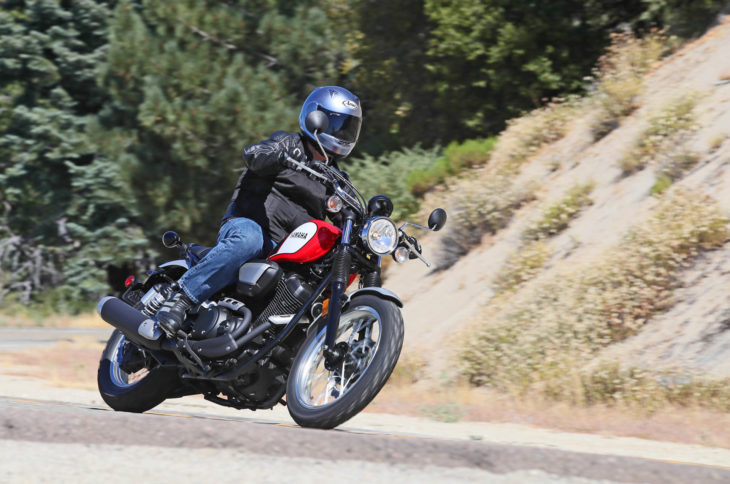
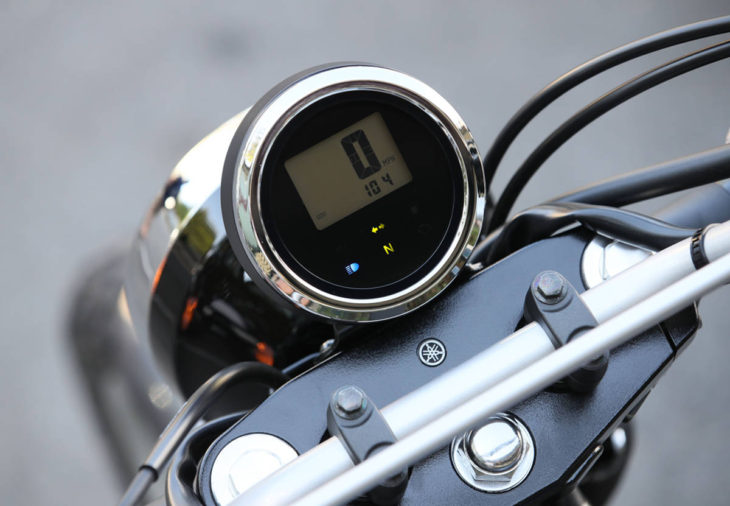
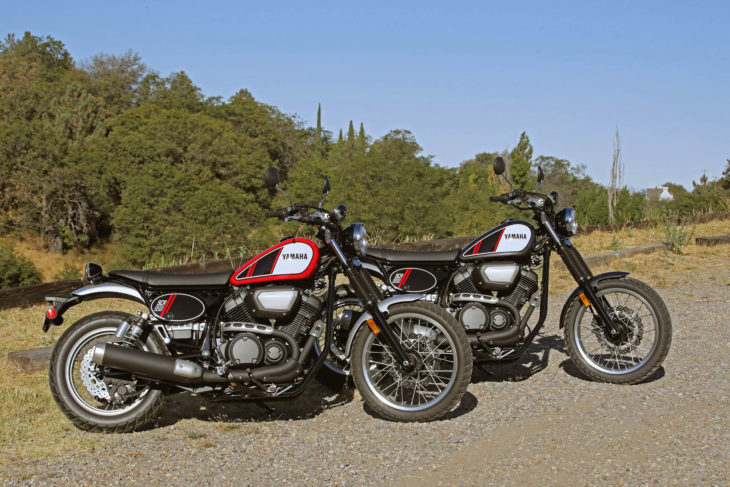
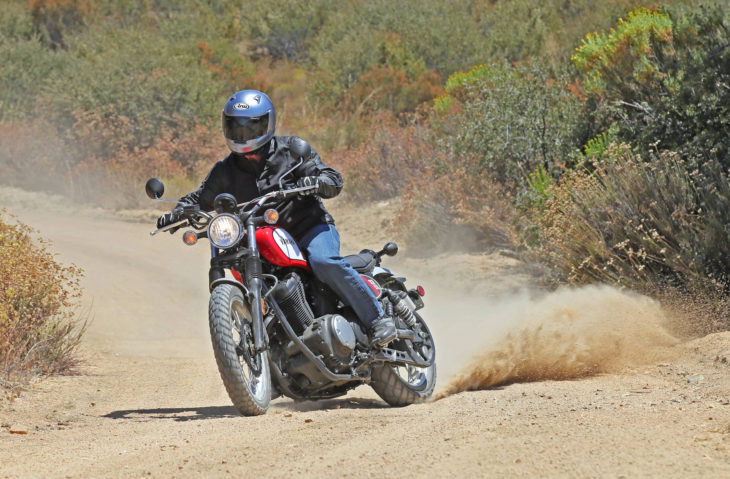
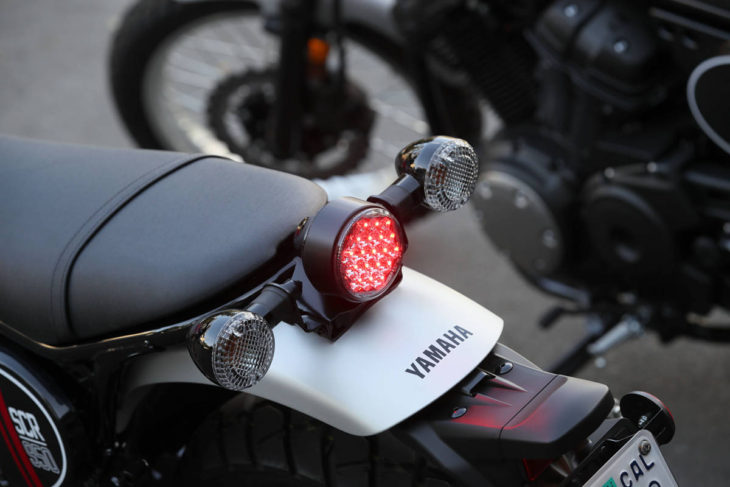
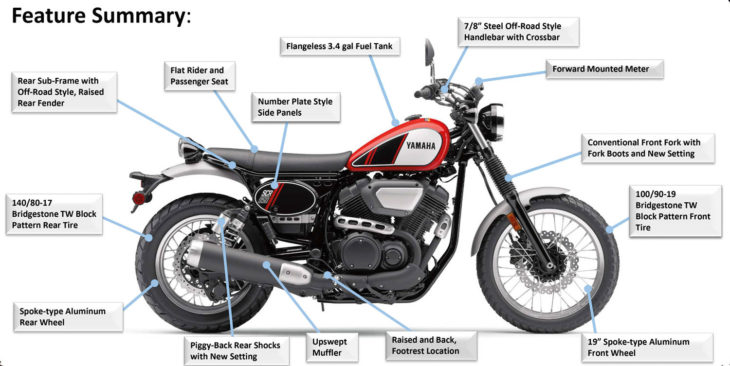
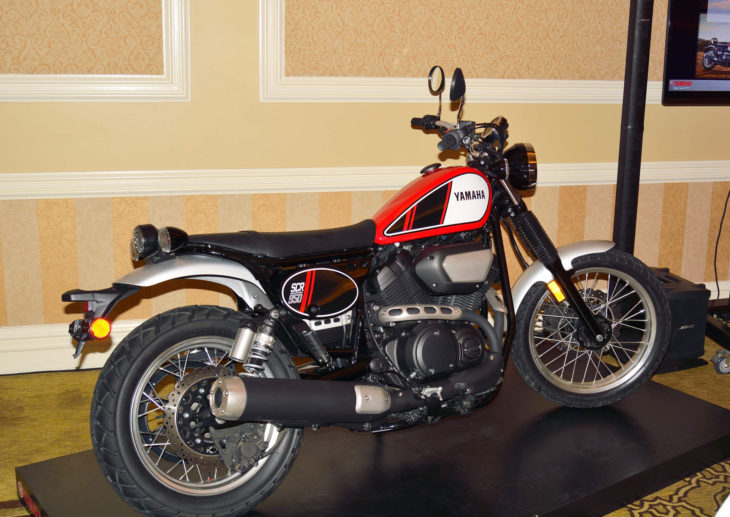
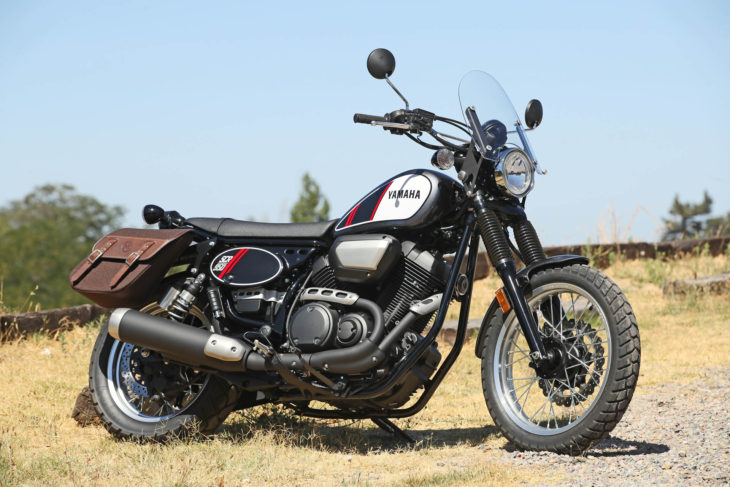
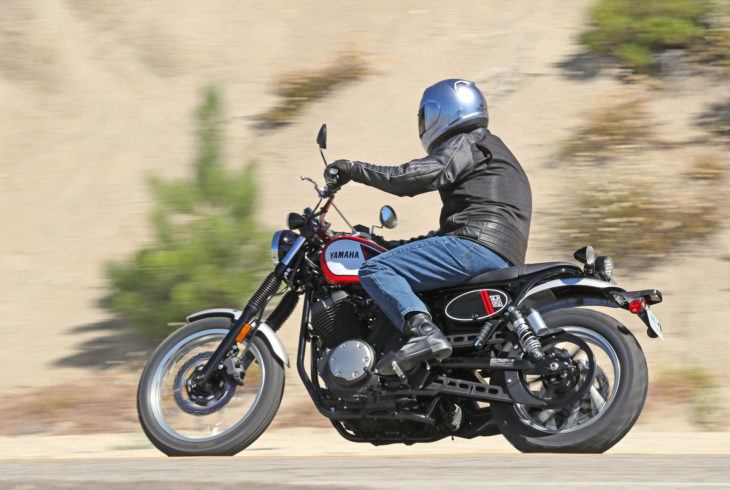






What neat bike! To plant my 65+ year-old arthritic fat ass on something comfortable, dependable and able to travel long distances without complaining is a Godsend. If Royal Enfield doesn’t come up with a 2017 Interceptor or Constellation, that Yamaha SCR950 will have a welcome home in my garage.
As an ex-owner of a Yamaha 1 litre VTwin, I can say these machines have a charm all of their own. As an old, cranky bastard, I don’t want to fold myself up into a contorted shape to ride a “cruiser” or “sport” bike. A simple standard does it for me. One that does it all – that can take me on the highway comfortably, lets me stand up for bumps or if on a mild fire road, and one with a standard riding position and a flat seat I can move around on. Being trapped in one position leads to muscle cramps, for us geriatrics. Having some ground clearance allows for some fun in the corners. Having a bit of bulk and weight actually comes in useful when riding on a windy day. And having good looks doesn’t hurt (the bike, definitely not me!). This bike seems to hit the spot. I like it.
Yup. I like this bike more than the Bolt. I just don’t understand why they didn’t use a longer rear shock. There’s certainly room for it. Cost considerations I guess. No tank seam.(yeah, I went there.)
So YAMAHA gives us a 400# FZ-1 for the street and a 550# “Scrambler” for the dirt. Perhaps their engineers need to actually get out and ride bikes before attempting to design them? A lighter bike for the dirt is always better and few more pounds on the street doesn’t really hurt much
It’s not a dirt bike, you muppet.
Bwahaha. I saw what you did there.
The Japanese OEM’s just can’t figure out the simple equation. “Beginner bikes in the 9K range will not sell !” What a joke to compare this to a Sportster, I’m sure not a single sportster shopper will even give a Yamaha a second look.
What have you been Huffing?
Reality ?
Isn’t a Sporty a women’s Harley? You know the one she rides by herself, following her Manly man on his bike, looking scared stiff and not very happy?
They are girl’s bikes according to the Harley Big Twin riders.
Much better motor than a Sportster.
I’m sick of these big street bikes getting tagged as ‘Scramblers’
What a joke.
You’re right – 547 lbs is not a scrambler in any form. 400 lbs is where they need to be.
Of all the Bolt variants, this one’s the best. It looks like fun. I’ll take a look at one soon.
It’s a nice bike all accounts, but something about the design just looks wrong to me. Same with the cafe version of this bike. The cruiser lines and dimensions just don’t seem to translate well to these other styles.
I want 2 front disc brakes to give it a finished off look.
I like it , more of a standard of the 70s and 80s, 5 gallon tank would be better.
Not too bad looking but for the many reasons already stated it would never be on my list. The Ducati Srambler does everything better.
Hate the tail light. Can you say Harley XR 1200 wannabee? I’ll pass, but then I’m not looking for anything like this at all. Don’t like the bolt either.
Belt drive bike sliding in the dirt?…bye bye belt! Come on.
Is this “no belts on dirt” thing an internet myth or something? I’ve ridden a belt-driven Buell thousands of miles on gravel roads and off-road: dirt, rocks, branches, and all manner of unfortunate forest creatures have likely found there way between the sprocket and belt many times with nary a problem. Same for the few others I’ve known that used their Buells off-road. A guy I’ve worked with for the past 8 years rides his belt-driven Sportster six miles everyday down the stretch of gravel road he lives on, and his belt is original.
I’d never argue that a chain isn’t more reliable than a belt off-road (the chain is my preferred final drive), but my admittedly limited observations have me believing that modern belts are more durable than the internet would lead us to believe.
I agree. I have a close friend in the U.P. that rides the dog crap out of his Buell on all manner of gravel/dirt/fire/logging roads and he has never complained about belt issues that I’m aware of. A chain would be preferable for sure, but I don’t think belts are as big a liability as people assume.
I ride my Zero SR offroad quite a bit. Nothing too rough, just some gravel roads and a few dirt ones. Sometimes I’ll spin the tires in the grass just for the heck of it. The belt is fine. I’ve seen photos of gravel embedded in a belt, but the real belt killer is supposed to be jumping while being on power. So don’t do jumps and your belt will probably be fine.
Compare it to a Ducati Scrambler.
The Scrambler is lighter, more powerful, has more suspension travel, and ABS.
Not even a good comparison, really. The Scrambler gives you more of everything “for a few dollars more.”
Compare it to the real deal, my ’72 Yamaha RT2 360cc enduro; 32hp and 220 lbs vs 46hp and 530 lbs. the 360 is much better in the dirt and has similar performance. Pretty sad, really.
It looks nice though.
Todd, I don’t want to take the wind out of your sails but your specs on the RT2 are a bit off. The 32 horsepower was at the crank so figure around 27 at the rear wheel and the wet weight spec on that bike in street trim was 262 pounds. The RT was a true dual purpose bike and a good one while the 950 “Scrambler” is a dirt bike in name only.
The original Yamaha Street Scramblers, YDS3C, YM2C, YDS6C etc, were equally not very good in the dirt. In fact they were awful off pavement but pretty successful as styling options. Think of the SCR as more like the Honda CL350/450 models and you get the idea. Street scramblers are cool looking but not really dirt competent.
Right on, Curly!
Ok, then that brings the Bolt a little closer to it performance wise!
“…a motorcycle that blurs the line between ‘cruiser’ and ‘sportbike’.”
No! I have enough blurred lines as it is with my presbyopia. I prefer distinct, clearly defined lines. The clear line this effort draws is the line that separates what I want from what I don’t. 5 lbs. heavier and $300 more than the Bolt R with no perceivable advantages I can see off pavement or anywhere else. Am I missing something?
Well the riding position is much better than the previous Bolt models which aren’t all that bad as standard cruisers. This variation make it more of a modern standard. Now if they’d just ditch that knee knocker air cleaner and drop 50 pounds it would be a winner.
I really want to like this bike — air cooled, simple, mid 70’s Yamaha XT/DT retro styling cues. But, 547 pounds?? Come on Yamaha, get the lead out. That should be a sub 500 pound bike.
Agreed. Not sure why I would buy this over an XSR900 if I was looking a modern retro-styled bike. Air-cooled v-twin sound isn’t worth 117 pounds more weight.
Just be glad it isn’t water cooled. It’d be a real porker then.
Like Butch mentioned, the engine reminds me of the old Honda Ascot, which was (IMO) one of the prettiest bikes out there. I hate to say it, but the Tailight looks like Yamaha finished designing the bike……then remembered they left off the taillight and had to quickly plop it on somewhere??
“Working against the scrambler idea is the same suspension travel found on the other Bolt models, including 4.7 inches in front and 2.8 inches out back.”
Ding ding ding… Any real-world (not just here in CO but easily in target markets like SF DMZ) roads, forget it
Dear Yamaha, please remove the Bolt-anchor you mistakenly installed in the SCR700 and put the liquid cooled 700 parallel twin back please? Oh, and swap the shocks and forks back too – I need the 2-3 inches of travel restored. Then take my money!
Heck Dirk… power slide on dirt… with a 5++ something pounds bike that is meant for taking you on style from your house to the nearest Starbucks? and check that it will bottom out both suspensions???? Yikes….
You still have to do the shootout with the Duc Scrambler.
Mr. Brian kudos for the photos.
Every once in a while, one of the Big Four gets it right: a stylish bike, form following function with an intangible “I can’t explain it…but I like it!”
This bike…isn’t an example. Not even close. Bleah.
Your last sentence was a perfect zinger for the first sentence. Funny.
When is a Bolt NOT a Bolt? Never
When it’s a screw?
Or nut?
I’m pleasantly surprised at the positive review. I’m curious as to how a motorcycle with 2.8″ of travel doesn’t bottom out on the street when there are 4″ bumps out there. Maybe a half inch each from the tires and seat, but then we’re still a quarter inch short.
MD-Please tell Harley-Davidson, Indian and Victory why this style of bike is a good idea.
An Ascot on steroids.
Wire wheels, check.
V twin, check
19 front 17 rear, check
$1400 more will get you the Ducati Scrambler.
6 speed tranny, considerably lighter and more hp.
Man, I like the looks of this bike, and I’m all for more choices in the (increasingly crowded) scrambler category. But two things make me cross this bike off the list of potential purchases. Weight and suspension travel. Too bad, I really wanted to like this bike.